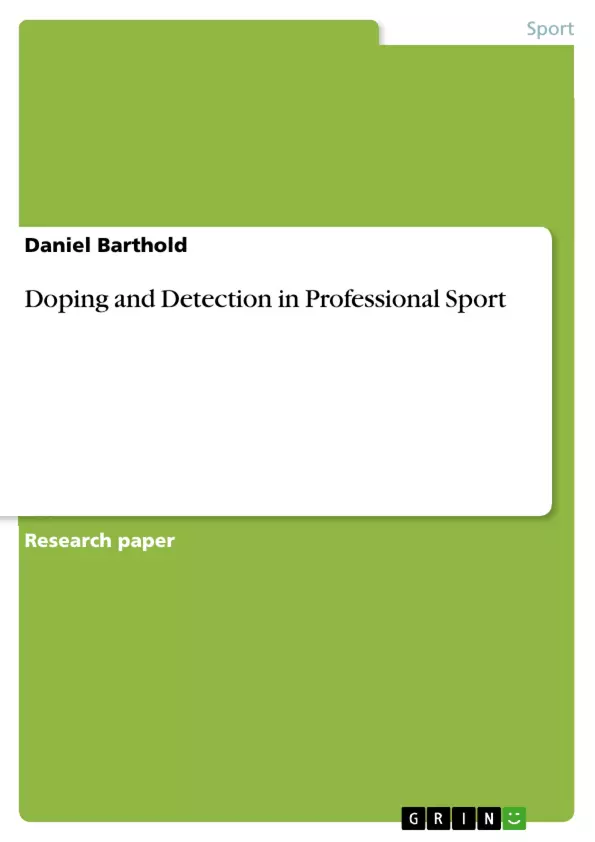Im Jahr 2006 und 2007 wurde die Radsportwelt von unzähligen Dopingfällen erschüttert, die vor allem durch das Beschuldigen mehrerer Top-Fahrer, wie Jan Ulrich, Ivan Basso oder Floyd Landis, flächendeckendes Ausmaß annahm. Die damit verbunden notwendige Analyse des Dopings im Radsport und im speziellen der Tour de France, befasst sich mit den gegebenen Dopingmethoden, wie EPO- und Blutdoping blickt aber auch auf neuartige Dopingmethoden und möglicher Aufdeckungsmethoden. Zudem beschreibe ich in meiner Arbeit auch die biochemischen Vorgänge des Doping, deren Effekt und Folgen.
Inhaltsverzeichnis (Table of Contents)
- Introduction
- The use of performance enhancing substances
- EPO-Doping
- Blood-doping
- Types of blood-doping
- Performance enhancing tests
- Health risks of doping
- Detection of doping
- Testosterone doping
- New doping methods in professional sport
- Detection of gene doping and health risks
- Doping and detection - Policies of the WADA and professional cycling organizations
Zielsetzung und Themenschwerpunkte (Objectives and Key Themes)
This work examines the use of performance enhancing substances in professional cycling, focusing on EPO-doping, blood-doping, and testosterone-doping. It analyzes the mechanisms of these doping methods, their physiological effects, and their detection, as well as the impact of doping on professional cycling events, particularly the Tour de France. The text further explores the policies and practices of anti-doping organizations, such as the World Anti-Doping Agency (WADA), in combating doping in professional cycling.- The impact of performance enhancing substances on professional cycling
- The mechanisms and effects of EPO-doping, blood-doping, and testosterone-doping
- The evolution of doping detection methods and technologies
- The role of anti-doping organizations in combating doping in professional cycling
- The challenges of maintaining a clean sport and restoring public trust
Zusammenfassung der Kapitel (Chapter Summaries)
The introduction provides a general overview of the widespread use of performance enhancing substances in professional cycling, highlighting the impact of doping scandals on the reputation of the sport, particularly the Tour de France. It emphasizes the need to understand different types of doping, including EPO-doping, blood-doping, and testosterone-doping, and how these methods affect the performance and health of cyclists. Chapter 2 delves into the specifics of performance enhancing substances, focusing on the three main types mentioned: EPO-doping, blood-doping, and testosterone-doping. The chapter examines the reasons behind the use of these substances, including the pressures athletes face to achieve success, and the ethical implications of choosing to use performance enhancing substances. Chapter 2.1, specifically focusing on EPO-doping, explores the biological function of Erythropoietin (EPO), a naturally occurring protein hormone produced by the body. It discusses the mechanisms of EPO production in the kidneys, its role in red blood cell production, and its impact on oxygen transport and athletic performance. Chapter 2.2 discusses blood-doping, highlighting the various techniques used to manipulate blood volume and red blood cell count for competitive advantage. The chapter explores the physiological effects of these methods, including their benefits and risks to the athlete's health. Chapter 2.3 expands on the types of blood-doping, outlining specific techniques and their associated risks. Chapter 2.4 examines performance enhancing tests used to detect doping, highlighting the challenges of developing and implementing effective detection methods. Chapter 2.5 addresses the health risks associated with doping, emphasizing the potential negative consequences for the athlete's physical and mental well-being. Chapter 3 focuses on the detection of doping, exploring the methodologies and challenges involved in identifying the use of performance enhancing substances. Chapter 4 delves into testosterone doping, examining the physiological effects of this type of doping on athletic performance, particularly its impact on muscle formation and aggression. Chapter 5 explores the emergence of new doping methods in professional sport, specifically focusing on gene doping, its potential for enhancing performance, and the associated health risks. Chapter 6 discusses the policies of the World Anti-Doping Agency (WADA) and professional cycling organizations in combating doping, highlighting the challenges faced by these organizations in enforcing regulations and maintaining a clean sport.Schlüsselwörter (Keywords)
This work focuses on the themes of doping in professional cycling, particularly EPO-doping, blood-doping, and testosterone-doping. It explores the mechanisms of these doping methods, their physiological effects, and the development and use of detection methods. The text further examines the role of anti-doping organizations in combating doping in professional cycling, emphasizing the challenges of maintaining a clean sport and restoring public trust. Key terms include: EPO, erythropoietin, blood-doping, testosterone-doping, gene doping, anti-doping, WADA, Tour de France, professional cycling, performance enhancing substances, health risks, ethical considerations, detection methods.
Ende der Leseprobe aus 25 Seiten
- nach oben
- Arbeit zitieren
- Daniel Barthold (Autor:in), 2008, Doping and Detection in Professional Sport, München, GRIN Verlag, https://www.grin.com/document/135534
Blick ins Buch



